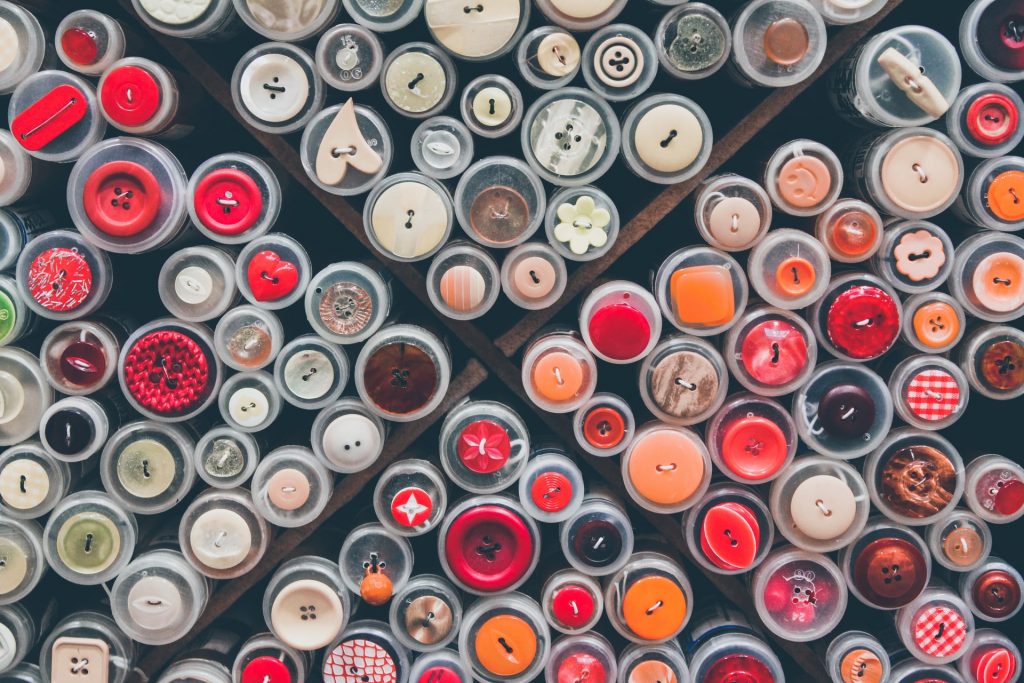Okay, so only some of us have an actual dedicated room for our sewing. Those lucky ones aside, your sewing room can be fashioned from any spare room in your home. Suppose you don’t have a dedicated space. In that case, your sewing area can be in a guest bedroom between guests, an unused closet, or just a corner of your dining table.
Regardless of how elegant or basic your sewing space is, there are ways to make it work better and more efficiently. We’ve scoured the offerings of sewing machine manufacturers, fabric stores, and home sewing organizations to find the best ways for you to maximize your sewing space.
Choosing a Sewing Space
Large or small, able to fit just a portable machine or a giant quilting machine with a specialized table, your space needs to be efficient. You need to quickly and easily reach your tools, support your fabric, and see exactly what your machine is doing.
If you have a separate room…
If you have a spare bedroom or space in a basement, you are indeed in luck. You can furnish the room with everything you’ll ever need for sewing for you, your family, and your home. These pieces of furniture will help you stay organized. A bare floor makes it easier to keep neat—there’s little more difficult than cleaning fabric scraps and thread from a carpet.
- Sewing table
- Cutting table
- Adjustable armless chair with rollers
- Ironing board
- Closed cupboard or bookshelf for storage
- Closet pole or moveable rack for hangers
- Containers for thread and filled bobbins
- Extras
- Chair mat
- Sewing lamp
- Magnified lamp
If you can command the corner of a room…
You might have space in a kitchen corner or a nook in a bedroom. If you have an area that can accommodate a 3’ by 5’ space dedicated to your stitchery, your corner is still workable. For convenience, if you can leave the machine and tools up and ready to use, it will save a lot of bother, plus you’ll be more likely to use the sewing machine.
- Small sewing table
- Adjustable armless chair with rollers or kitchen chair
- Tabletop ironing board
- Roll-away plastic drawer unit
- Containers for thread and filled bobbins
If you use part of a table…
Tiny living quarters may leave you with no room to spare permanently. You’ll need to plan carefully to design a workable sewing space within its limitations. First, buy your furniture with an eye to how easily you can store it. A cutting board, all your tools, and an ironing board (full size or tabletop) can all be stashed underneath a bed. The sewing machine itself can be stored in the bottom of a closet until needed.
- A kitchen or dining table for cutting and sewing
- Chair
- Ironing board
- Container for sewing tools
- Containers for thread and filled bobbins
Tools for Planning, Cutting, Sewing, and Finishing
Sewing is likened to carpentry, just as cooking is to chemistry. Sewists need tools; some are necessary, and others are nice to have. Depending on your budget and space you have for storage, this list will get you off to a fine start.
The following is in order of necessity. The first tools are must-haves and, as we go down the list, the rest are either very useful or at least nice to have.
Preparing the fabric for cutting…
Basic:
- Scissors and shears, including small embroidery scissors, dressmaker’s 7-inch shears, and pinking shears
- Tailor’s chalk or non-permanent ink markers
- Pins, both sharp and ball-point
- Pincushion filled with sand or other sharpening substance
- Needles for basting and hand-finishing
- Sewing machine needs in standard sizes.
- Containers for holding spools of thread or bobbins
- Ruler
- Iron & ironing table
Intermediate (add these):
- Self-healing mat and rotary cutter
- T-square
Advanced (add these):
- French curves templates
- Templates for marking and cutting quilt top pieces
Sewing your project or garment
Essential:
- Sewing machine
- Seam ripper
Closures for your project or garment
Essential:
- Buttonholer feature/foot on a sewing machine
- Sharp embroidery scissors
- Tailor’s chalk or non-permanent ink markers
- 6-inch metal measure with slide
- Buttonhole marker measure
- Pins, sharp or ball-point for knits
- Hand needles
- Zipper presser foot for sewing machine
Hemming your project or garment
Essential:
- Garment length measuring device like a yardstick
- 6-inch metal measure with slide
- Pins, sharp or ball-point for knits or clips
- Hand needles and matching thread
Intermediate/Advanced:
- Floor-mounted hem marker
- Hemming foot for sewing machine
Embellishing your project
As needed:
- Rick-rack tape
- Bias tape
- Hem tape
- Ribbons
- Findings
Hacks for adding to your stash
If you do any kind of sewing or other needlework, you’ll soon start to collect a stash. The stash is where you store all those things that will, someday soon, become a brilliant new project. It’s just a matter of time and judicious picking.
There are some great places to scour in search of stashable items.
- From friends
- From sewing clubs
- Garage and estate sales
- Ads on sites like Craigslist
- Sales at fabric stores
- Online coupons and sales
- Promotional goods from sewing websites
Read more


